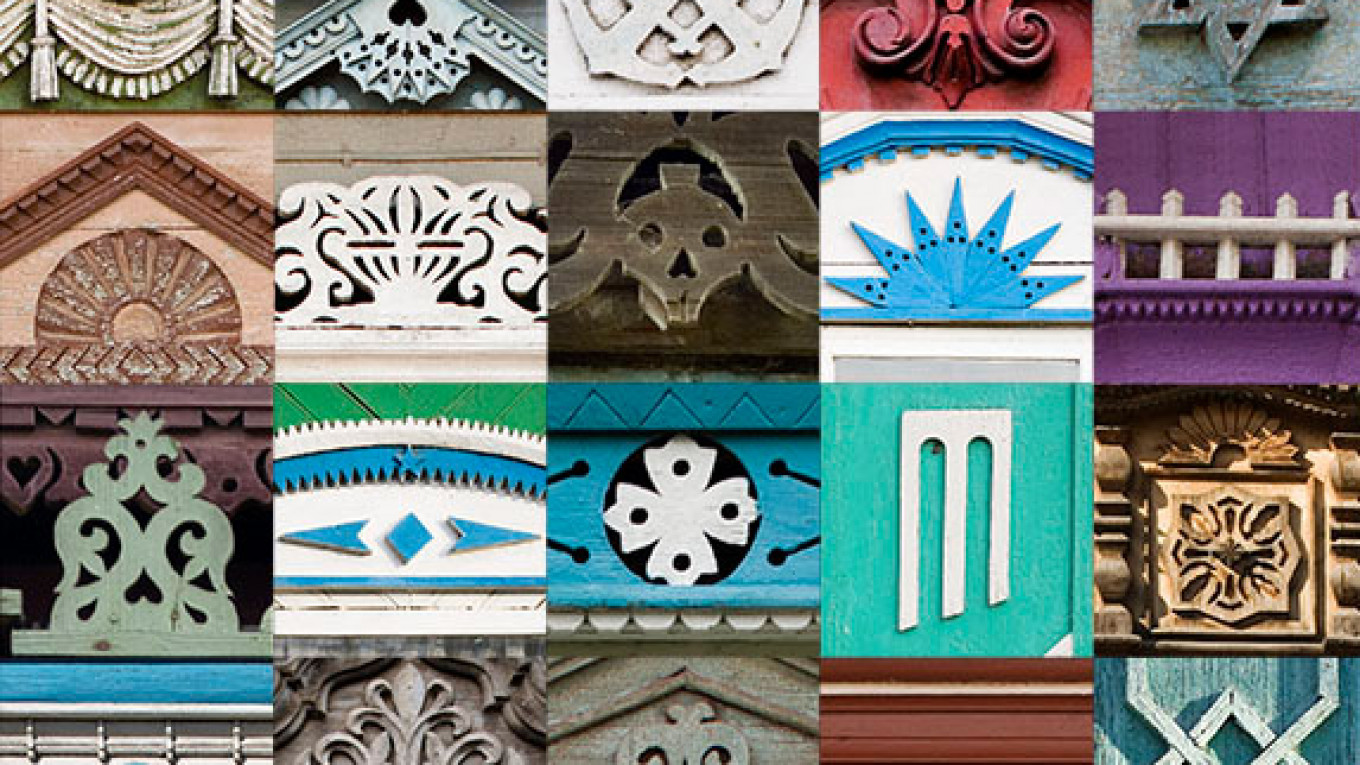For most foreigners, a stereotypical Russian scene typically involves wood — wooden matryoshkas, wooden sleighs, and hand-carved wooden peasant huts. For those who live in Russia's capital, where vistas are generally dominated by concrete, asphalt and steel, wood may seem to be a semi-mythical building material.
Two groups are working separately to both preserve Russia's remaining wooden antiquities as well as celebrate new wooden architecture in the country. On the Internet, the "Virtual Museum of Decorated Windows," or Nalichniki.com, is seeking to catalog hand-carved wooden window frames, known as nalichniki, from around the country. Meanwhile, here in Moscow at the Central House of Artists, the winners of the Arkhiwood 2013 competition for Russian wooden modern architecture are on display.
"Civilization is bringing the masters to their knees," said Ivan Khafizov, the founder of the Nalichniki.com project, in an interview with the newspaper Sobesednik. Khafizov decried the rapid disappearance of traditional styles of Russian architecture, stating that Russian cities are being rebuilt "according to 'euro-fashion.'"
Partially to preserve this disappearing heritage, Khafizov created his website, dedicated to gathering photographs of Nalichniki. The term nalichnik refers to the ornate wooden carvings, frequently coupled with shutters, which traditionally decorated windows in villages throughout Russia.
Khafizov said in an interview with Cyrillitsa.ru that "only one thing unites all the regions [where nalichniki can be found] — Russian language." In other words, these wooden decorations can be found in a vast area, from Moscow to Vladivostok, but differ widely in style and color, with individual villages and regions often having extremely distinctive and uniform nalichniki.
Nalichniki are a wholly unstudied facet of Russian folk art. "Khokhloma, Gzhel, Palekh — even abroad, people recognize these names. Yet no one has even bothered to come up with names for the different types of nalichniki yet," Khafizov said. This diversity makes these nalichniki a fascinating field of study, and Khafizov hopes to preserve as many as possible in his photo archive. Khafizov already has photographs of several buildings that have since been demolished.
While Khafizov seeks to preserve Russia's historic wooden architecture, a whole new generation of young architects are returning to wood as a choice material for wholly new designs. Every year since 2010, the Arkhiwood competition has selected the best productions of these young artists for special mention, and photographs of this year's batch are currently on display in a special wooden installation outside of the Central Artist's House in Moscow.
"We do modern architecture — for us there were no other options for this project," said Grigory Dainov, overall winner of this year's Arkhiwood contest, speaking about his prize-winning house in an interview with Archi.ru. Dainov, an architect working for his own firm, DK, designed this year's top jury pick, a small dacha on the outskirts of Yaroslavl.
While Dainov says that he built the house in a modern style, his perceptions of "modern" differ greatly from typical Russian modern structures constructed with brick and glass. Dainov's two-story dacha uses sharp lines, light wood, and extensive windows to create a light and airy interior, emphasized by the white walls and wood panelling.
Dainov first got his start with more traditional architecture: An Orthodox chapel on Kotorosli Embankment in Yaroslavl was the first building he designed. However, he recognized that his newest structures are wholly unlike other local structures, saying: "No, there is nothing like it, the others [neighboring houses] are all totally traditional for Yaroslavl."
Dainov's house is not the only winner of the Arkhiwood contest — houses and structures from across the country also received prizes in various categories. Many of these structures are clustered in Moscow, where buildings like the new Garage exhibition center and the Ostrovok cafe-terrace, both in Gorky Park, won prizes.
Photographs of all of the Arkhiwood prizewinners are displayed in a wooden installation that snakes along the front portico of the Central House of Artists. Long and winding with numerous small alleys and rooms, the installation creates the impression of actually being inside one of the prizewinning buildings.
However, it is interesting to note that of all the Arkhiwood prizewinners, not one of them has Nalichniki — though wooden architecture may continue to be refined in Russia, it seems that some facets are being lost on the way.
The Arkhiwood contest winners are on display outside the Central Artist's House, ?TsDKh, at 10 Krymsky Val. Metro Park Kultury. 499-238-9634. The Virtual Museum of Decorated Windows is on permanent display on the Internet at nalichniki.com.
Contact the author at g.golubock@imedia.ru
A Message from The Moscow Times:
Dear readers,
We are facing unprecedented challenges. Russia's Prosecutor General's Office has designated The Moscow Times as an "undesirable" organization, criminalizing our work and putting our staff at risk of prosecution. This follows our earlier unjust labeling as a "foreign agent."
These actions are direct attempts to silence independent journalism in Russia. The authorities claim our work "discredits the decisions of the Russian leadership." We see things differently: we strive to provide accurate, unbiased reporting on Russia.
We, the journalists of The Moscow Times, refuse to be silenced. But to continue our work, we need your help.
Your support, no matter how small, makes a world of difference. If you can, please support us monthly starting from just $2. It's quick to set up, and every contribution makes a significant impact.
By supporting The Moscow Times, you're defending open, independent journalism in the face of repression. Thank you for standing with us.
Remind me later.


